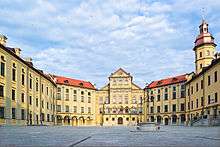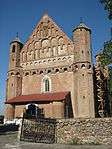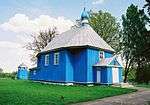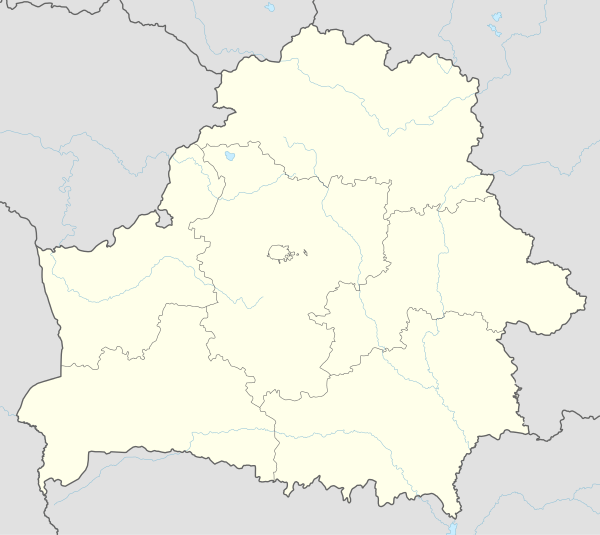List of World Heritage Sites in Belarus
The United Nations Educational, Scientific and Cultural Organization (UNESCO) World Heritage Sites are places of importance to cultural or natural heritage as described in the UNESCO World Heritage Convention, established in 1972.[1] Currently, four properties in Belarus are inscribed on the World Heritage List. The tentative list of Belarus contains eleven properties.[2] Three properties are cultural and one is natural.[2]
World Heritage Sites
UNESCO lists sites under ten criteria; each entry must meet at least one of the criteria. Criteria i through vi are cultural, whereas vii through x are natural.[3]
| Site | Image | Location | Year listed | UNESCO data | Description |
|---|---|---|---|---|---|
| Belavezhskaya Pushcha National Park (Białowieża Forest) | Brest Province and Grodno Province | 1992 | 33ter; vii (natural) | Bialowieza Forest conserves a diverse complex of protected forest ecosystems, including extensive old-growth forests, which exemplify the Central European mixed forests terrestrial ecoregion, and a range of associated non-forest habitats, including wet meadows, river valleys and other wetlands. The area is home to the largest free-roaming population of European Bison. The Polish part of the site was first added to the list in 1979. The part in Belarus was added in 1992 and the year 2014 saw a large extension of the protected area.[4] | |
| Mir Castle Complex | .jpg) |
Mir, Grodno Province | 2000 | 625; ii, iv (cultural) | Mir Castle is an exceptional example of a central European castle, reflecting in its design and layout successive cultural influences (Gothic, Baroque, and Renaissance) that blend harmoniously to create an impressive monument to the history of this region. The region in which Mir Castle stands has a long history of political and cultural confrontation and coalescence, which is graphically represented in the form and appearance of the ensemble. |
| Struve Geodetic Arc |  |
Brest Province and Grodno Province | 2005 | 1187; ii, iii, vi (cultural) | The Struve Geodetic Arc is a series of triangulation points, stretching over a distance of 2,820 kilometres (1,750 mi) from Hammerfest in Norway to the Black Sea. The points were set up in a survey by the astronomer Friedrich Georg Wilhelm Struve who first carried out an accurate measurement of a long segment of a meridian – and along with it the size and shape of the Earth. Originally, there were 265 station points. The World Heritage Site includes 34 points in ten countries (North to South: Norway, Sweden, Finland, Russia, Estonia, Latvia, Lithuania, Belarus, Moldova, Ukraine), five of which are in Belarus.[5] |
| Architectural, Residential and Cultural Complex of the Radziwill Family at Nesvizh |  |
Nesvizh, Minsk Province | 2005 | 1196; ii, iv, vi (cultural) | The Architectural, Residential and Cultural Complex of the Radziwill Family at Nesvizh was the cradle for the introduction of new concepts based on the synthesis of Western traditions, leading to the establishment of a new architectural school in Central Europe. |
Tentative list
In addition to sites inscribed on the World Heritage List, member states can maintain a list of tentative sites that they may consider for nomination. Nominations for the World Heritage List are only accepted if the site was previously listed on the tentative list.[6] As of 2019, Belarus lists five properties on its tentative list.[2]
| Site | Image | Location | Year listed | UNESCO criteria | Description |
|---|---|---|---|---|---|
| Augustow Canal |  |
Grodno Province | Cultural (i, ii) | 2004 | 1892 |
| Saviour Transfiguration Church and St. Sophia Cathedral in the town of Polatsk |  |
Polotsk, Vitebsk Province | Cultural (i, ii) | 2004 | 1893 |
| SS. Boris and Gleb (Kalozha) Church in the city of Hrodna |  |
Hrodna | Cultural (i, ii) | 2004 | 1895 |
| Edifices for Worship of Fortress Type in Belarus, Poland and Lithuania |  |
Brest Province and Minsk Province | Cultural (i) | 2004 | 1899 |
| Worship wooden architecture (17th–18th centuries) in Polesye |  |
Brest Province and Gomel Province | Cultural (i, ii, iii) | 2004 | 1901 |
References
- "The World Heritage Convention". UNESCO World Heritage Centre. Retrieved 21 September 2010.
- Belarus – UNESCO World Heritage Centre
- "UNESCO World Heritage Centre The Criteria for Selection". UNESCO World Heritage Centre. Retrieved 17 August 2018.
- https://whc.unesco.org/en/list/33
- "Struve Geodetic Arc".
- "Tentative Lists". UNESCO World Heritage Centre. Retrieved 7 October 2010.

.svg.png)
